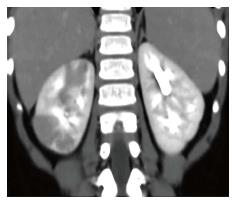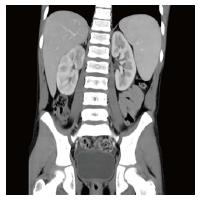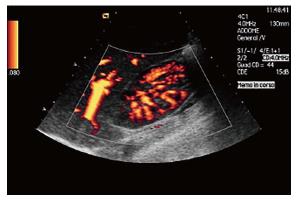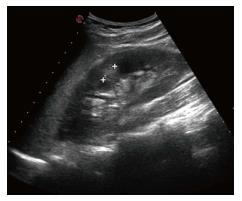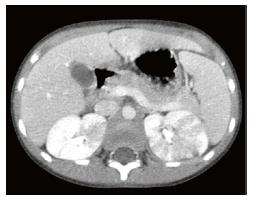Copyright
©The Author(s) 2016.
World J Clin Pediatr. Feb 8, 2016; 5(1): 136-142
Published online Feb 8, 2016. doi: 10.5409/wjcp.v5.i1.136
Published online Feb 8, 2016. doi: 10.5409/wjcp.v5.i1.136
Figure 1 Case 1: Abdominal computed tomography.
Computed tomography scan of the abdomen after intravenous contrast injection reveals multiple wedge-shaped hypo dense non enhanced lesions in the right kidney, more visible in the upper and lower pole.
Figure 2 Case 2: Abdominal computed tomography.
Abdominal computed tomography after contrast medium administration, showing a notable hypodense area in the upper pole of right kidney.
Figure 3 Case 2: Abdominal ultrasound.
Abdominal ultrasonography with power-doppler analysis shows two hypoperfused areas at the upper pole of right kidney.
Figure 4 Case 3: Abdominal ultrasonography.
Abdominal ultrasonography shows an increased volume of the left kidney with a small hyperechoic mass (1 cm diameter) in the middle zone of the kidney.
Figure 5 Case 4: Abdominal computed tomography.
Computed tomography scan of the abdomen after intravenous contrast injection reveals multiple wedge-shaped cortical hypodense lesions in the both kidneys, more represented in the left one.
Figure 6 Diagnostic algorithm to suspect and then recognize acute lobar nephritis in children.
ALN: Acute lobar nephritis; CT: Computed tomography; MRI: Magnetic resonance imagine.
- Citation: Bibalo C, Apicella A, Guastalla V, Marzuillo P, Zennaro F, Tringali C, Taddio A, Germani C, Barbi E. Acute lobar nephritis in children: Not so easy to recognize and manage. World J Clin Pediatr 2016; 5(1): 136-142
- URL: https://www.wjgnet.com/2219-2808/full/v5/i1/136.htm
- DOI: https://dx.doi.org/10.5409/wjcp.v5.i1.136













